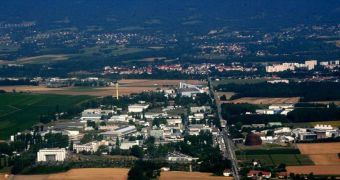Scientists working at the Large Hadron Collider (LHC), underneath Geneva, say that the machine may be used for shedding more light on the origins of life. This conclusion was drawn after a group of elite experts discussed the idea in a workshop.
The purpose of the meeting was to determine whether the massive scientific experiment, which is now used to figure out the origins of the Universe, could be used to establish how life first emerged.
Chemists and biologists who participated at the workshop say that it is possible to use the world's largest particle accelerator for this purpose. The LHC is managed by the European Organization for Nuclear Research (CERN).
The collider is buried some 100 meters below the French-Swiss border, and comprises of a massive, 27-kilometer-long tunnel, with adjacent facilities. It can achieve energy levels of 7 teraelectronvolts per beam, for a total energy output of 14 TeV.
Experts now use it to analyze proton collisions, in an attempt to determine how the Universe looked and behaved like only a fraction of a second following the Big Bang, 13.75 billion years ago.
But the LHC grid may also be used for other applications. “We are hoping to use the computing grid to perform [future] simulations and analyses, which would enable us to go much further and deeper than we have been able to do so far,” says expert Wim Hordijk.
“We have already done some small test runs just to make sure our software runs on the LHC grid, which seems to be the case,” adds the scientist, who is a computational and bioinformatics specialist at the University of Lausanne, in Switzerland.
[…] “the crucial step towards life was the formation of autocatalytic sets. An autocatalytic set is a group of molecules which undergo chemical reactions in which some of the molecules catalyze other reactions in the set,” ISGTW reports.
“Importantly, though, all molecules mutually catalyze each other’s creation, meaning that autocatalytic sets are ‘self-sustaining’,” experts add. The LHC may help produce a deeper insight into this phenomenon, helping evolutionary biologists piece together this complex puzzle.
Of course, it could be that life didn't develop here at all, but rather that organic molecules were brought in by comets, and somehow manage to find a good environment to thrive. On the other hand, it's possible that both scenarios are true to some extent, Daily Galaxy reports.

 14 DAY TRIAL //
14 DAY TRIAL //